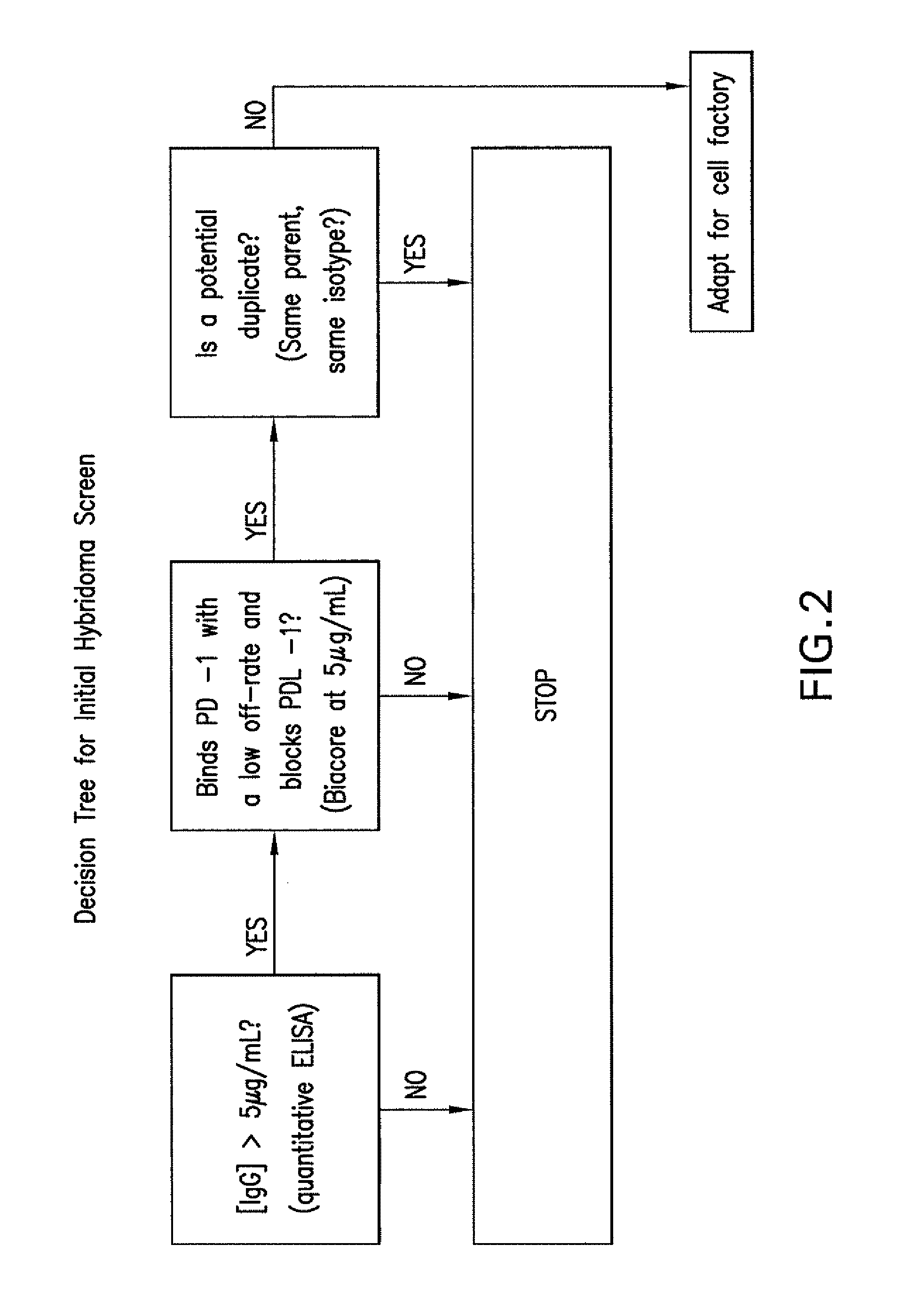PD-1 binding proteins
a technology of binding proteins and pd-1, which is applied in the field of pd-1 binding proteins, can solve the problems of poor prognosis for many human cancer types, high degree of pd-l1 expression in tumors (detected by immunohistochemical staining), and reverse scenario can also be deleterious, so as to enhance host anti-microbial immunity, enhance host anti-cancer immunity, and regulate t cell responses.
- Summary
- Abstract
- Description
- Claims
- Application Information
AI Technical Summary
Benefits of technology
Problems solved by technology
Method used
Image
Examples
example 1
Generation of Monoclonal Antibodies to PD-1
[0228]Monoclonal antibodies directed to human PD-1 (SEQ ID NO:1) were generated by vaccinating mice with a DNA expression vector which encodes human PD-1.
[0229]Construction of PD-1 vector for mouse vaccination and hybridoma generation: Synthetic nucleotide gene fragments encoding amino acid sequences of human PD-1 (SEQ ID NO:1; NCBI Genbank Accession no. NP—005009) were constructed. The fragments were inserted into the V1Jns vector (SEQ ID NO:3; Shiver et al., “Immune Responses to HIV gp120 Elicited by DNA Vaccination,” in Vaccines 95, Eds. R. M. Chanock, F. Brown, H. S. Ginsberg & E. Norrby, Cold Spring Harbor, N.Y.: Cold Spring Harbor Laboratory Press, 1995, 95-98) at Bgl II site to create V1Jns-PD-1. The authenticity and orientation of the inserts were confirmed by DNA sequencing.
[0230]Production of stable cell lines: For generation of permanent cell lines, PD-1 and PD-L1 (SEQ ID NO:2; NCBI Genbank Accession no. AAP13470) fragments were ...
example 2
Biophysical Screening
[0232]Further screening was accomplished by biophysical methods. The flowchart in FIG. 2 was followed. Concentrations of hybridoma supernatants were determined by a quantitative anti-mouse IgG ELISA, and if the concentration was greater than 5 μg / mL, supernatants were diluted to 5 μg / mL. Clones producing less than 5 μg / mL mouse IgG were not pursued.
[0233]An assay was then developed on the Biacore® platform to determine binding to PD-1, blocking of PD-L1, and to counter-screen for the human Fc portion of a recombinant PD-1 / Fc fusion protein (R&D Systems) used. Biacore® instruments incorporate microfluidics technology and surface plasmon resonance (SPR). The angle of polarized light reflecting from the side of a gold-coated sensor opposite to the solution phase is a function of the evanescent wave extending into the solution phase and sensitive to the refractive index near that interface. This refractive index is proportional to the mass density of adsorbates (e.g...
example 3
In Vitro Cell-Based Binding and Blocking Data
[0237]Several in vitro experiments were performed to determine both the binding of each identified mAb to cells expressing PD-1 and the ability to block PD-L1. 293 cells were transfected to express PD-1 on their cell membranes. Human CD4+ cells were activated by incubation with anti-CD3 / anti-CD28 beads (approximately 1 bead: 1-2 cells) for 48-72 hours at 37° C. Rhesus CD4+ cells (2×106 cells / mL) were activated by incubation in plates coated with 1 μg / mL anti-CD3 / anti-CD28 for 24-72 hours at 37° C.
[0238]The results are summarized in Table 4. Criteria for further development included the following: a: binding to PD-1 on human CD4 cells (>100 relative MFI units), b: cross-reactive with PD-1 on rhesus CD4 cells (>700 relative MFI units), c: blocking of recombinant human PD-L1 / Fc binding to PD-1 expressed on transfected 293 cells (>90% inhibition), d: blocking of recombinant human PD-L1 / Fc binding to human PD-1 on activated human CD4 T cells (...
PUM
| Property | Measurement | Unit |
|---|---|---|
| temperatures | aaaaa | aaaaa |
| concentration | aaaaa | aaaaa |
| concentration | aaaaa | aaaaa |
Abstract
Description
Claims
Application Information
 Login to View More
Login to View More - R&D
- Intellectual Property
- Life Sciences
- Materials
- Tech Scout
- Unparalleled Data Quality
- Higher Quality Content
- 60% Fewer Hallucinations
Browse by: Latest US Patents, China's latest patents, Technical Efficacy Thesaurus, Application Domain, Technology Topic, Popular Technical Reports.
© 2025 PatSnap. All rights reserved.Legal|Privacy policy|Modern Slavery Act Transparency Statement|Sitemap|About US| Contact US: help@patsnap.com



